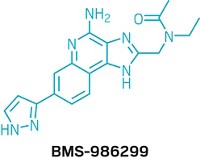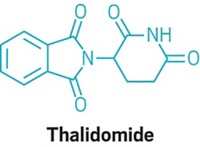Advertisement
Grab your lab coat. Let's get started
Welcome!
Welcome!
Create an account below to get 6 C&EN articles per month, receive newsletters and more - all free.
It seems this is your first time logging in online. Please enter the following information to continue.
As an ACS member you automatically get access to this site. All we need is few more details to create your reading experience.
Not you? Sign in with a different account.
Not you? Sign in with a different account.
ERROR 1
ERROR 1
ERROR 2
ERROR 2
ERROR 2
ERROR 2
ERROR 2
Password and Confirm password must match.
If you have an ACS member number, please enter it here so we can link this account to your membership. (optional)
ERROR 2
ACS values your privacy. By submitting your information, you are gaining access to C&EN and subscribing to our weekly newsletter. We use the information you provide to make your reading experience better, and we will never sell your data to third party members.
Pharmaceuticals
Drug Candidates March Onward
Therapeutics for psoriasis, cancer, Alzheimer's, and cardiovascular and muscle diseases progress
by Stu Borman
September 26, 2005
| A version of this story appeared in
Volume 83, Issue 39
ACS MEETING NEWS
It's often said lately that the pharmaceutical industry has been going through a dry spell in developing new drugs. But if the plethora of talks on new medications at the ACS national meeting last month in Washington, D.C., is any indication, the industry's barren period might not last all that long.
Researchers at the meeting discussed a wide range of new therapeutic agents under development. Among those described in sessions organized by the Divisions of Carbohydrate Chemistry (CARB) and of Medicinal Chemistry (MEDI) alone were several already in clinical trials or getting close. These include drugs for psoriasis and other autoimmune conditions, cancer and tumor metastasis, melanoma, cardiovascular disease, and muscular dystrophy.
One autoimmune and two cancer drugs were described at a CARB symposium on iminosugars, compounds in which a ring oxygen or carbon in a conventional sugar is replaced with a nitrogen to introduce a cationic center. Iminosugars have proven to be a rich source of therapeutic drug candidates in the past few years and have thus become a special focus of research attention.
Biochemistry professor Vern L. Schramm at Albert Einstein College of Medicine, Bronx, N.Y., and coworkers have been concentrating on iminosugars in their efforts to identify drug leads by analyzing reaction transition states.
In the technique, an enzyme associated with a human disease is selected, the potential surface of the substrate transition state (the surface with which the enzyme interacts) is determined, and substrate transition-state analogs are synthesized and tested for inhibitory activity.
IN EARLIER WORK, Schramm and coworkers used this approach to identify inhibitors of human purine nucleoside phosphorylase (PNP), an enzyme associated with cancer and autoimmune diseases. PNP has been a popular target for drug design, but it has been difficult to identify highly potent inhibitors for it.
Schramm and coworkers solved this problem with transition-state analysis. They determined the transition-state structure of bovine PNP's enzyme's substrate in 1993; collaborated with Industrial Research, of Lower Hutt, New Zealand, to synthesize potential inhibitors; and in 1998 identified a highly potent one, the iminoribitol immucillin-H (Fodosine), an iminosugar of 9-deazainosine. In 2000, the compound was licensed to BioCryst Pharmaceuticals, of Birmingham, Ala., and it recently advanced to clinical trials for resistant and relapsed T-cell cancers and B-cell leukemia.
At the ACS meeting, Schramm and coworkers described transition-state analysis of human PNP to design a second-generation compound. It's a methylene-bridged hydroxypyrrolidine called DADMe-immucillin-H, a deazaazadeoxy methylene (DADMe) derivative of immucillin-H. Trade-named BCX-4208, DADMe-immucillin-H has better specificity for human PNP than immucillin-H, and BioCryst Pharmaceuticals currently has it in Phase I trials for psoriasis and other autoimmune disorders.
Schramm and coworkers also recently used transition-state analysis to identify a family of tightly binding hydroxypyrrolidine analogs of methylthioadenosine that inhibit methylthioadenosine nucleosidase (MTAN). MTAN is a bacterial enzyme involved in quorum sensing, a phenomenon associated with biofilm formation and bacterial pathogenicity. Schramm says the new agents are among the most powerful noncovalent enzyme inhibitors ever reported, and his team hopes to develop them as bacterial antibiotics.
Also on the trail of iminosugar-based drugs are Yoshio Nishimura, associate director of the Microbial Chemistry Research Center, Tokyo, and coworkers. They are pursuing iminosugar inhibitors of enzymes involved in tumor metastasis as potential cancer therapeutics.
According to Nishimura, tumor metastasis occurs by a complex multistage process that includes tumor invasion through blood vessel membranes. To enter and exit blood vessels, many kinds of tumor cells secrete heparanase to break down vascular membranes. Nishimura and coworkers have synthesized geminal-diamine 1-N-iminosugars that block the activity of heparanase and thereby inhibit tumor metastasis efficiently in animal models.
Among these are SF-4 and SDD-8, potent inhibitors of heparanases associated with melanoma. Both have been shown to prevent cancer cell invasion in membrane assays and to potently suppress pulmonary metastasis of tumors in mice, and neither has shown toxicity in the mouse studies. In addition, "we have developed a better candidate and are now evaluating its activity in vivo," Nishimura said.
The agents are candidates for chemotherapeutics to prevent cancer spread. The researchers are still trying to optimize them, and "a company is interested in them for preclinical trials," Nishimura said.
Meanwhile, professor of pediatrics and biochemistry and molecular biology Stephan Ladisch of Children's National Medical Center and George Washington University School of Medicine, Washington, D.C., and coworkers are trying to curb tumor growth with iminosugar inhibitors of tumor ganglioside synthesis.
The synthesis and secretion of gangliosides by tumor cells has been shown to block immune responses against tumor growth and also to promote angiogenesis, the development of blood vessels to supply tumors. Therefore, inhibiting ganglioside synthesis might be an effective way to fight cancer.
Ladisch and coworkers identified an orally available iminosugar, OGT2378, that inhibits glucosylceramide synthesis, a process upon which ganglioside synthesis depends. The iminosugar has been shown to curtail melanoma growth in treated mice to one-tenth that in control mice.
"Cancer cells produce gangliosides at a much more rapid rate than do normal cells," Ladisch explained. "By interfering with this process, we can stop a tumor from growing in a rather dramatic fashion without damaging the normal tissue surrounding it."
Although Ladisch and coworkers do not yet know the precise molecular mechanism of the effect, "what we do know is that we are changing the tumor's own mechanics to stop its growth," he said. "This novel approach to treating cancers could serve either as an alternative to traditional cancer-fighting therapies with harsh side effects--such as chemotherapy and radiation treatment--or as a supplement to these standard treatments." It may still be several years, however, before human clinical trials are carried out, Ladisch said.
At a MEDI session on neurodegenerative diseases, Mark A. Findeis, vice president of research at Satori Pharmaceuticals, Boston, told attendees about his team's search for therapeutic approaches to Alzheimer's disease.
Alzheimer's is the most common neurodegenerative disease, currently afflicting about 4.5 million people in the U.S., Findeis said. Current therapies are considered palliative in that they typically can slow progression of the disease by months but cannot halt the inevitable decline of Alzheimer's patients. Findeis and coworkers believe they have identified a compound that may represent a new kind of Alzheimer's treatment.
The disease's early presymptomatic stage is characterized by the development in the brain of deposits formed from Aβ42, a long form of amyloid-ß peptide (Aβ). "Many of the mutations known to be associated with inherited forms of Alzheimer's disease specifically increase the level of this form of Aβ," Findeis said. Aβ42 is also known to be more prone to misfold and aggregate than shorter forms of A β and to be more toxic to cells in its aggregated form. Researchers are thus trying to find ways to lower levels of "long Aβ."
Findeis and coworkers licensed a botanical extract from the Mayo Clinic, Rochester, Minn., and isolated specific compounds associated with Aβ-lowering activity. One of these, SP1, is the group's lead compound for development.
SP1 potently and selectively lowers levels of Aβ42 in cellular assays and has promising activity in animals. It is structurally distinct from and orders of magnitude more potent than previously known Aβ-lowering agents. "Alas, we are not quite yet ready to show the world what this structure is," Findeis said.
In another MEDI session, James G. Douglass III, a principal investigator in medicinal chemistry at Inspire Pharmaceuticals, Durham, N.C., discussed INS50589, a potent and selective inhibitor of platelet aggregation that is being developed for use in acute treatment of cardiovascular diseases. The drug is "reversible," meaning that its activity dissipates quickly when administration is discontinued, permitting levels of platelet aggregation to return to normal. Platelet aggregation forms thrombi (blood-factor aggregates), which can cause strokes, heart attacks, and other problems.
In the body, adenosine 59-diphosphate (ADP) is one of the main regulators of platelet aggregation and consequent thrombus formation. This process begins when two G-protein-coupled receptors, P2Y1 and P2Y12, are activated simultaneously by ADP. The receptors are attractive targets for antithrombotic medications, because inhibiting the binding of ADP at either one reduces platelet aggregation. "We studied the structure-activity relationships of modified mono- and dinucleotides at P2Y12 and identified lipophilic modifications to the ribose and base moieties that imparted potent, selective, and reversible antagonist properties at this receptor," Douglass said. These studies led to the identification of INS50589 as a drug candidate, owing to its strong binding to and potent inhibition of the P2Y12 receptor.
In preclinical studies and in a recently completed Phase I trial, the compound was shown to be a potent and reversible inhibitor of platelet aggregation. Inspire plans to develop it as an agent that will inhibit platelet aggregation and activation during cardiopulmonary bypass procedures. The drug's reversibility would enable normal platelet function to be restored quickly after surgery, potentially reducing postoperative complications such as blood loss and minimizing the need for transfusions of blood or blood products.
ANOTHER AGENT discussed in a MEDI session is an inhibitor of the enzyme calpain that's being developed as a treatment for Duchenne muscular dystrophy (DMD).
DMD is a recessive X chromosome-linked disorder characterized by progressive muscle wasting. It is generally diagnosed at about the time babies start to walk, and it affects approximately one in 3,500 newborn boys worldwide.
Affected patients inevitably become wheelchair-bound as teenagers and die at a young age from heart or respiratory failure, said senior scientist Holger Herzner of Santhera Pharmaceuticals, Liestal, Switzerland. So far, no effective treatment is available to slow or stop such muscle deterioration.
The condition is caused by mutations of the dystrophin gene, which lead to a deficit of functional dystrophin, a structural protein in cells. Dystrophin deficiency, in turn, causes the calcium-dependent enzyme calpain to become activated, resulting in muscle damage from abnormal cleavage of muscle cell proteins. According to Herzner, "There is strong evidence from animal experiments that inhibition of this enzyme can substantially slow down the progression of muscle deterioration."
Herzner and coworkers at Santhera have developed a series of small-molecule calpain inhibitors optimized for cellular uptake into muscle cells. Peptide-derived  -ketoamides such as SNT197958 exhibited nanomolar activity in the group's in vitro assays and have also shown promising activity in mdx mice, an animal model for DMD. "Currently, Santhera is performing preclinical toxicology and pharmacokinetic tests as a further step to develop these inhibitors as a treatment option for DMD," Herzner said.
-ketoamides such as SNT197958 exhibited nanomolar activity in the group's in vitro assays and have also shown promising activity in mdx mice, an animal model for DMD. "Currently, Santhera is performing preclinical toxicology and pharmacokinetic tests as a further step to develop these inhibitors as a treatment option for DMD," Herzner said.










Join the conversation
Contact the reporter
Submit a Letter to the Editor for publication
Engage with us on Twitter